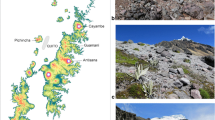Abstract
Grapsid crabs are one of the most common, and potentially important, elements of the mangrove fauna but relatively little information is available on patterns in their distribution and abundance. In part, this may be due to difficulties in estimating the abundance of burrowing species. By not having reliable methods of estimating changes in distribution and abundance of crabs, ecological impacts of crabs may be greatly underestimated. We tested several methods for estimating the apparent abundance of eight species of grapsids in a north Australian mangrove forest. These methods included continuous and instantaneous visual counts at two distances, two types of pitfall traps and photography. We also excavated crabs to test the reliability of the best of these methods. Overall, pitfall traps equipped with funnels proved most useful, although these did preferentially capture larger crabs. An exception was the large crab, Neosarmatium meinerti, which was rarely captured and more reliably estimated by burrow counts. Traps proved to be most useful in this study and may be for long term studies of grapsid species, however, the selection of a method should be made after careful evaluation of the questions and relevant information required for any particular study. Finally, these methods may also prove to be useful in other environments such as salt marshes.
Similar content being viewed by others
References
G. Caughley (1971) Analysis of Vertebrate Populations John Wiley and Sons London
F. Dahdouh-Guebas M. Verneirt J.F. Tack D. Speybroeck ParticleVan N. Koedam (1997) ArticleTitleFood preferences in Neosarmatium meinerti de Man (Decapoda: Sesarminae) and its possible effect on the regeneration of mangroves Hydrobiologia 347 83–89 Occurrence Handle10.1023/A:1003015201186
W.D. Emmerson (2000) ArticleTitleAspects of the population dynamics of Neosarmatium meinerti at Mgazanaa, warm temperate mangrove swamp in the East Cape, South Africa, investigated using an indirect method Hydrobiologia 449 221–229
W.D. Emmerson L.E. McGwynne (1992) ArticleTitleFeeding and assimilation of mangrove leaves by the crab Sesarma meinerti de Man in relation to leaf-litter production in Mgazana, a warm-temperate southern African mangrove swamp J. Exp. Mar. Biol. Ecol. 157 41–53 Occurrence Handle10.1016/0022-0981(92)90073-J
S.D. Frusher R.L. Giddins T.J. Smith SuffixIII. (1994) ArticleTitleDistribution and abundance of grapsid crabs (Grapsidae) in a mangrove estuary: effects of sediment characteristics, salinity tolerances, and osmoregulatory ability Estuaries 17 IssueID3 647–654
F. Golley H.T. Odum R.F. Wilson (1962) ArticleTitleThe structure and metabolism of a Puerto Rican red mangrove forest in May Ecology 43 9–19 Occurrence Handle1:CAS:528:DyaF38XotV2jtQ%3D%3D
P. Johnson (2003) ArticleTitleBiased sex ratios in fiddler crabs (Brachyura, Ocypodidae): a review and evaluation of the influence of sampling method, size class, and sex-specific mortality Crustaceana 76 559–580 Occurrence Handle10.1163/156854003322316209
D.A. Jones (1984) Crabs of the mangal ecosystem F.D. Por I. Dor (Eds) Hydrobiology of the Mangal Dr. W. Junk Publisher The Hague, Netherlands
J. Jordao R. Oliveira (2003) ArticleTitleComparison of non-invasive methods for quantifying population density of the fiddler crab Uca tangeri J. Mar. Biol. Assoc. UK 83 IssueID5 981–982
S.Y. Lee (1998) ArticleTitleEcological role of grapsid crabs in mangrove ecosystems: a review Mar. Freshwater Res. 49 335–343 Occurrence Handle10.1071/MF97179
K.A. McGuinness (1994) ArticleTitleThe climbing behaviour of Cerithidea anticipata (Mollusca: Gastropoda): the role of physical versus biological factors Aust. J. Ecol. 19 283–289
K.A. McGuinness (1997a) ArticleTitleDispersal, establishment and survival of Ceriops tagal propagules in a north Australian mangrove forest Oecologia 109 80–87 Occurrence Handle10.1007/s004420050061
K.A. McGuinness (1997b) ArticleTitleTests for artefacts in some method used to study herbivory and predation in mangrove forests Mar. Ecol. Prog. Ser. 153 37–44
K.A. McGuinness (1997c) ArticleTitleSeed predation in a north Australian mangrove forest: a test of the dominance–predation model J. Trop. Ecol. 13 293–302
F. Micheli F. Gherardi M. Vannini (1991) ArticleTitleFeeding and burrowing ecology of two East African mangrove crabs Mar. Biol. 111 247–254 Occurrence Handle10.1007/BF01319706
M. Nobbs (1999) The behavioural ecology of Fiddler crabs (Genus: Uca) that live in the mangrove forests of Darwin Harbour Northern Territory University Australia
M. Nobbs K.A. McGuinness (1999) ArticleTitleDeveloping methods for quantifying the apparent abundance of fiddler crabs (Ocypodidae: Uca in mangrove habitats Aust. J. Ecol. 24 43–49
A.I. Roberston (1986) ArticleTitleLeaf-burying crabs: their influence on energy flow and export from mixed mangrove forests (Rhizophora spp. in northeastern Australia J. Exp. Mar. Biol. Ecol. 102 237–248
C.P. Salgado Kent (2004) The significance of plant–animal interactions: how crabs affect structure and function Charles Darwin University Australia
M.W. Skov R.H. Hartnoll (2001) ArticleTitleComparative suitability of binocular observation, burrow counting and excavation for the quantification of the mangrove fiddler crab Uca annulipes (H. Milne Edwards) Hydrobiologia 449 201–212 Occurrence Handle10.1023/A:1017598616178
M. Skov M. Vannini P.J. Shunula R.G. Hartnoll S. Cannicci (2002) ArticleTitleQuantifying the density of mangrove crabs: Ocypodidae and Grapsidae Mar. Biol. 141 IssueID4 725–732
T.J. Smith SuffixIII. (1987) ArticleTitleSeed predation in relation to tree dominance in distribution in mangrove forests Ecology 68 266–273
T.J. Smith SuffixIII K.G. Boto S.D. Frusher R.L. Giddins (1991) ArticleTitleKeystone species and mangrove forest dynamics: the influence of burrowing by crabs on soil nutrient status and forest productivity Estuar. Coast. Shelf Sci. 33 419–432 Occurrence Handle1:CAS:528:DyaK38XktVensg%3D%3D
Southwood T.R.E. and Henderson P.A. 2000. Ecological Methods. Blackwell Science Ltd.
J.H. Warren (1987) Behavioural ecology of crabs in temperate mangrove swamps. University of Sydney Australia
J.H. Warren (1990) ArticleTitleThe use of open burrows to estimate abundances of intertidal estuarine crabs Aust. J. Ecol. 15 277–280
Author information
Authors and Affiliations
Corresponding author
Rights and permissions
About this article
Cite this article
Kent, C.P.S., McGuinness, K.A. A Comparison of Methods for Estimating Relative Abundance of Grapsid Crabs. Wetlands Ecol Manage 14, 1–9 (2006). https://doi.org/10.1007/s11273-004-5075-6
Received:
Accepted:
Issue Date:
DOI: https://doi.org/10.1007/s11273-004-5075-6




